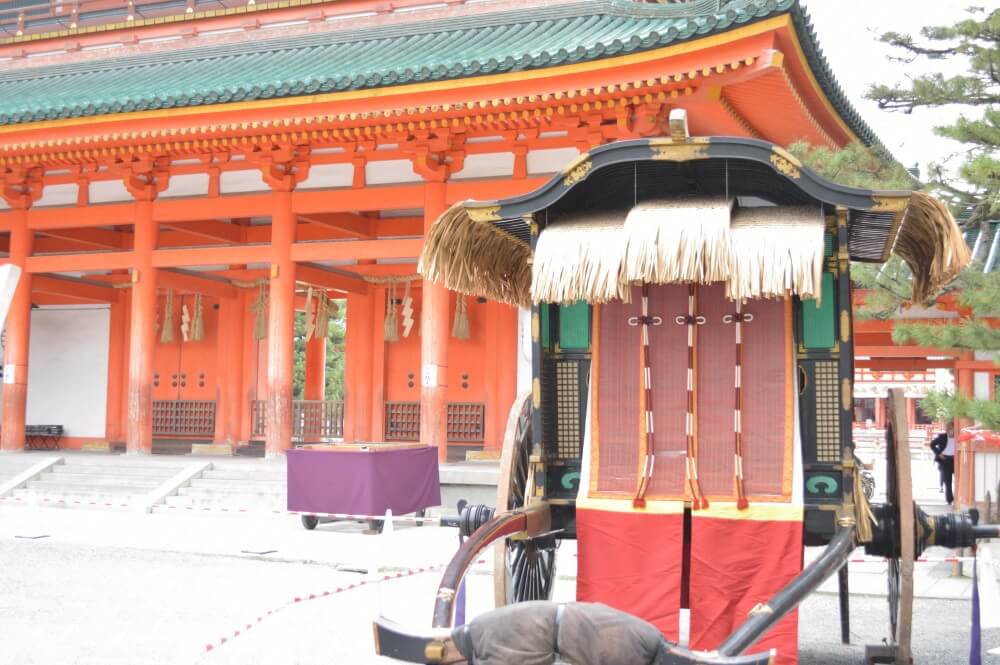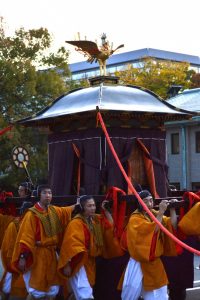THE GIST OF THIS ARTICLE
- Page 1 Schedul of 2025, What is Jidai Matsuri?, Reservation seat
- Page 2 Jidai Gyoretsu Parade 1: Shinkoretsu, Enryaku Period, Heian Period
- Page 3 Jidai Gyoretsu Parade 2: Kamakura period, Yoshin Period, Muromachi Period
- Page 4 Jidai Gyoretsu Parade 3: Azuchi Momoyama period, Edo Period, Meiji Ishin Period
- Page 5 The Route of Paeade
The following is the contents of this article.
Schedule of 2025
| DATE | HOURS | EVENTS | |
| 10/15 | 13:30 | Jidai Matsuri Senjo Sai 時代祭宣状祭 |
A ceremony praying for the safety of the parade at Heian Jingu |
| 10/21 | 10:00 | Jidai Matsuri Zenjitsu Sai 時代祭前日祭 |
A ceremony praying for the safety of Jidai Matsuri at Heian Jingu |
| 10/22 | 7:00 | Jidai Matsuri 時代祭 |
Priests report the begging of Jidai Matsuri to the Deities. |
| 8:00 | Sinko Sai 神幸祭 |
Priests bring the sprit of the Deities to Gohoren (Mikoshi) | |
| 9:00 | Gyoretsu Shupatsu 行列出発 |
The parade leaves Heian Jingu and arrives Kenreimon gate of Kyoto Imperial palace around 10:30 | |
| 10:30 | Anzaisho Sai 行在所祭 |
A ritual takes place in front of Kenreimon gate | |
| 12:00 | Gyoretsu Shinpatsu 行列進発 |
The parade leaves Kyoto Imperial palace for Heian Jingu | |
| 16:00 | Daigokuden Sai and Kanko Sai 大極殿祭並還幸祭 |
Priests bring the sprit of the Deities to the main hall (Not open to us) | |
| 10/23 | 10:00 | Jidai Matsuri Gojitsu Sai 時代祭後日祭 |
The end of Jidai Matsuri declared |

Many events take place in Jidai Matsuri. And so-called Jidai Matsuri is the PARADE indicated in red.
Check out the official site of Heianjigu shrine (In Japanese only)
What is Jidai matsuri festival?
Overview
Jidai matsuri festival is one of the famous three festival in Kyoto and held on 22th October annually. It started in 1895 as a celebration of an incident took place 1100 years ago: the transferral of the ancient capital from Nara to Kyoto. It is famous for the parade in which over 2,000 participants in the outfits of the ancient times.
The aim of the festival
Heian Jingu shrie holds Jidai matsuri festival. It enshrines two emperors as Deity; emperor Kanmu, who moved to the capital to Kyoto, and emperor Komei, the last empror who spent his life in Kyoto.
The purpose of the festival is to let them see what present-day Kyoto is like as a Shito ritual. So, the Deities make a round trip between Heian Jingu shrine and Kyoto Imperial palace.
Jidai matsuri is famous for its prade. It conststs of 10 units and 8 of them shows us the periods between 794 and 1868. Their outfits are exact replica of each period.
Schedule of Jidai matsuri festival
Overview
Jidai matsuri has many shinto rituals. They take place within a week.
October 15 13:00 Jidai matsuri Senjyo sai 時代祭宣状祭
Prior to the parede, it is held for the success of it at Heian Jingu shrine.
October 21 10:00 Jidai matsuri zenjitsu sai 時代祭前日祭
The eve of the festival is celebrated.
October 22 7:00 Jidai matsuri festival 時代祭当日
A ritulal is held at Heian Jingu shrine and the festival is started.
October 22 8:00 Shinko sai 神幸祭
Priests move the spirit of emperor Kanmu and Komei to palanquins called Gohoren (御鳳輦). These Gohoren depart Heian Jingu shrien to Kyoto Imperial palace.
October 22 12:00 The parade departs 出発
The parade leaves Kyoto Imperial palace to Heian Jingu shrine.
October 22 16:00 Daigokuden sai and Kanko sai 大極殿祭並還幸祭
The parade comes back to Heian Jingu shrien and the spirits of two emperos return to the shrine.
*Not open to public
Reservation seat to enjoy Jidai Matsuri

Following is the reservation of 2023. The one of 2024 not yet announced.
Check out the website of Kyoto Kanko Navi (in Japanese).
- Seats in front row 一般席最前列 6,500 JPY
- Seats in other rows 一般席二列目以降 4,500 JPY
- Special seat with audio guide in front row 10,500 JPY
- Special seat with audio guide in other rows 8,500 JPY
- Special seat in front of Ohtenmon of Heian Jingu shrine in front row 15,000 JPY
- Special seat in front of Ohtenmon of Heian Jingu shrine in other rows 13,000 JPY
ヤギの京都観光案内/KYOTO GOAT BLOGをもっと見る
購読すると最新の投稿がメールで送信されます。




